Easiest Rustic Sourdough Artisan Loaf
This flavorful sourdough artisan loaf comes together into a beautiful rustic boule that is light and airy. Beginner friendly, no knead, and no special tools required. What more could you ask for?

This post may contain affiliate links for your convenience.
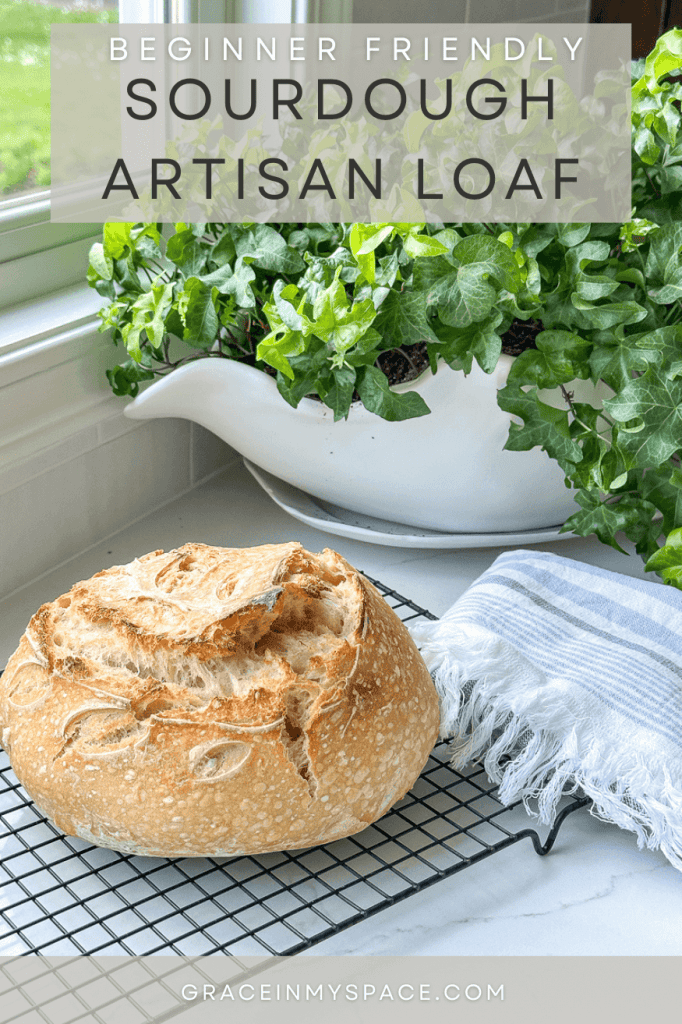
Sourdough Artisan Loaf Using All Purpose FLour
This recipe is extremely beginner friendly if you’re new to sourdough.
Most of my sourdough recipes use bread flour, however I wanted to offer an alternative for those who just have all purpose flour on hand.

View Details of My Kitchen Remodel Here
Just ensure that you are using unbleached all purpose flour and measuring accurately. This will be your best bet in getting a beautiful crumb.
Recipe Notes on Sourdough Starter
Ensure that you’ve fed your sourdough starter within the last 4-12 hours.
You will want to use your starter at its peak for this recipe to get the best rise.
The majority of the time that we see failed sourdough loaves, it is the starter to blame. Either it isn’t strong enough in the first place, or it wasn’t at its peak yet.
Make sure that your starter is robust and healthy before using for any sourdough recipe.
I am in Michigan and most of the year my kitchen is cold. I’m using 100 g of sourdough starter, which is helpful in colder climates. If you live in a warm climate, you may try 50-60 g of sourdough starter instead to avoid over proofing.

Whatever temperature you’re dealing with, watch this recipe closely in the bulk fermentation stage to avoid over or under proofing your dough.
Rustic Sourdough Artisan Loaf Recipe
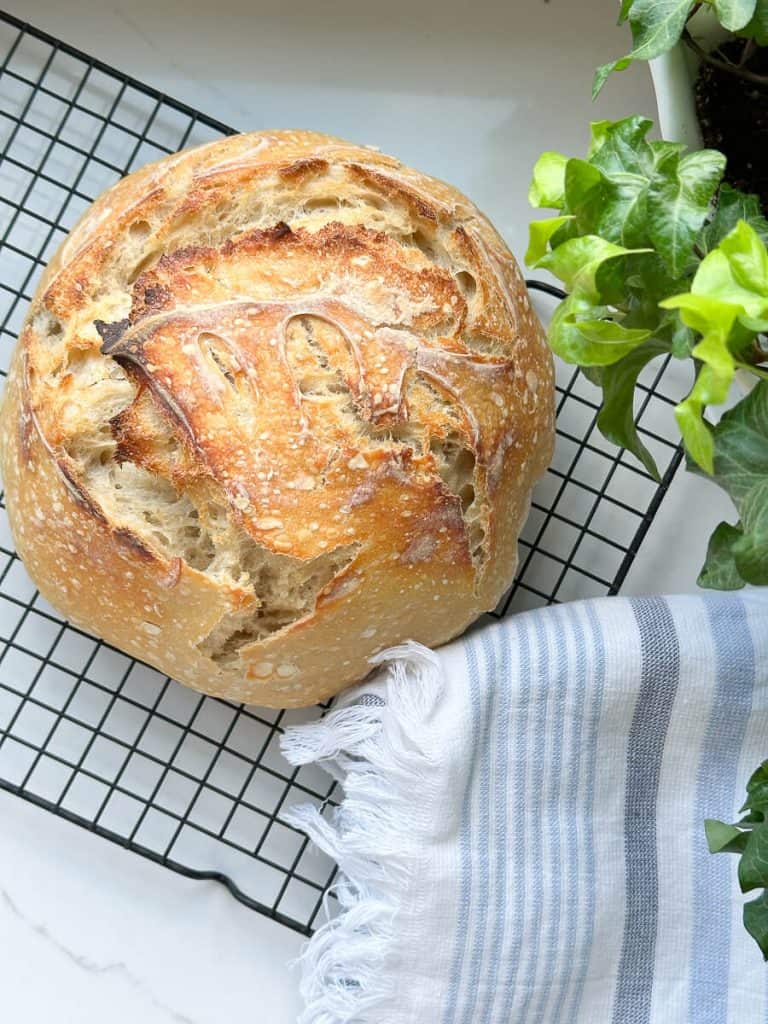
Baking Tools Needed
- glass mixing bowl (clear bowls make it easier to see bubbling activity)
- wooden spoon or spatula
- kitchen scale
- dutch oven
- banneton or similar sized round bowl with floured tea towel
Ingredients
- 100 g bubbly active sourdough starter (see notes above for variation)
- 320 g warm water
- 500 g all purpose unbleached flour
- 12 g fine sea salt (10 g for a lower sodium recipe)
I recommend using a kitchen scale for all measurements. They are very affordable and will make a big difference in how your sourdough artisan loaf turns out.
However, if you are in a pinch and do not have one, below are the general recipe conversions.
1/2 c sourdough starter, 1 1/4 c warm water, 4 c flour, 2 tsp salt
Recipe Instructions
- Mix 320 g warm water with 100 g sourdough starter until water is cloudy and all starter is mixed in.
- Add 500 g of flour and 12 g of sea salt to the wet ingredients and mix to form a shaggy dough. Let rest, covered with a towel or plastic wrap, for 15 minutes.
- Stretch & Fold: Perform 4 sets of stretch and folds 30 minutes apart to help develop the gluten. To perform one set of stretch and folds, grab one corner of the dough and lift straight up, then fold it down on top of the rest of the dough. Turn the bowl 1/4 turn and repeat this process until you’ve stretched and folded all four corners, completing a 360 of the bowl. (Re-cover the bowl between each set.)
Fermentation Process
- Bulk Fermentation: Cover the bowl with plastic wrap and let it rise on the counter until double in size (6-12 hours depending on your home’s conditions). At the end of this fermentation stage, you should see air bubbles forming, the dough should be jiggly, and if you poke your finger into the dough it should slowly rise back. During the poke test, if the dough bounces right back it is not ready for the next step. If it doesn’t rise back at all, it has over-proofed. Bake it anyway or turn it into focaccia.
- Shaping: Shape your dough into a boule. Most people would use a banneton for this step as it will give you the best shape. However, most beginners don’t have one and can simply use a round bowl and floured tea towel instead. Flour your work surface with rice flour, then pour your dough onto it. Shape your dough into a ball by gently cupping your hands on both sides, pushing with one and pulling back with the other. This creates tension in your dough. Once you have a taut ball, place it in your banneton or floured bowl and cover tightly.
- Cold Fermentation: Place your dough into the fridge for cold fermentation. This will help develop the flavor. Leave it refrigerated for at least 6 hours, up to 24.
Baking
- One hour before you plan to bake, preheat the oven to 450 F with your empty dutch oven inside.
- Right before you’re ready to bake, turn your dough onto a sheet of parchment paper and gently score. You can make a pretty design, or simply rough cut it with a pair of scissors. Wherever you score is where your bread will open when baking.
- Lift your dough into the hot dutch oven with the corners of the parchment paper. (I like to pour some uncooked rice into the bottom of my dutch oven to keep the bottom of my sourdough artisan loaf from burning.)
- Bake: Place the lid onto the dutch oven, and bake for 30 minutes. Then, remove the lid, lower the temperature to 410 F and bake for 10-15 minutes more.
- Your bread should be around 205 F internal temperature with a deep golden brown crust. Lightly browned bread is likely underdone and needs more cooking time.
- Remove your bread by lifting with the parchment paper and let it cool at least an hour on a wire rack before slicing.

Printable Sourdough Artisan Loaf Recipe
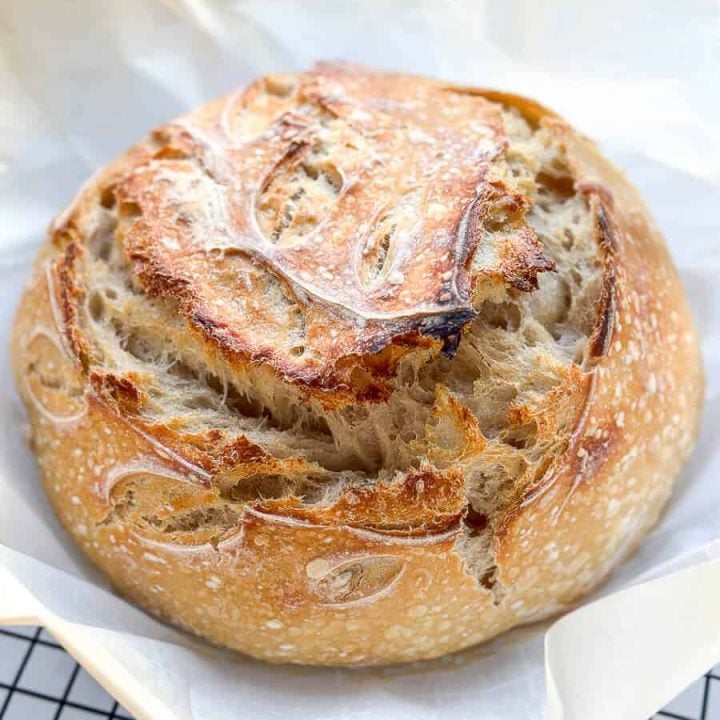
Easiest Rustic Sourdough Artisan Loaf
This flavorful sourdough artisan loaf comes together into a beautiful rustic boule that is light and airy. Beginner friendly, no knead, no special tools required.
Ingredients
- 100 g bubbly active sourdough starter (see notes for variation)
- 320 g warm water
- 500 g all purpose unbleached flour
- 12 g fine sea salt (10 g for a lower sodium recipe)
Instructions
- Mix 320 g warm water with 100 g sourdough starter until water is cloudy and all starter is mixed in.
- Add 500 g of flour and 12 g of sea salt to the wet ingredients and mix to form a shaggy dough. Let rest, covered with a towel or plastic wrap, for 15 minutes.
- Perform 4 sets of stretch and folds 30 minutes apart to help develop the gluten. To perform one set of stretch and folds, grab one corner of the dough and lift straight up, then fold it down on top of the rest of the dough. Turn the bowl 1/4 turn and repeat this process until you've stretched and folded all four corners, completing a 360 of the bowl. (Re-cover the bowl between each set.)
- Cover the bowl with plastic wrap and let it rise on the counter until double in size (6-12 hours depending on your home's conditions). At the end of this fermentation stage, you should see air bubbles forming, the dough should be jiggly, and if you poke your finger into the dough it should slowly rise back. During the poke test, if the dough bounces right back it is not ready for the next step. If it doesn't rise back at all, it has over-proofed. Bake it anyway or turn it into focaccia.
- Shape your dough into a boule. Most people would use a banneton for this step as it will give you the best shape. However, most beginners don't have one and can simply use a round bowl and floured tea towel instead. Flour your work surface with rice flour, then pour your dough onto it. Shape your dough into a ball by gently cupping your hands on both sides, pushing with one and pulling back with the other. This creates tension in your dough. Once you have a taut ball, place it in your banneton or floured bowl and cover tightly.
- Place your dough into the fridge for cold fermentation. This will help develop the flavor. Leave it refrigerated for at least 6 hours, up to 24.
- One hour before you plan to bake, preheat the oven to 450 F with your empty dutch oven inside.
- Turn your dough onto a sheet of parchment paper and gently score. You can make a pretty design, or simply rough cut it with a pair of scissors. Wherever you score is where your bread will open when baking.
- Lift your dough into the hot dutch oven. (I like to pour some uncooked rice into the bottom of my dutch oven to keep the bottom of my sourdough artisan loaf from burning.)
- Place the lid onto the dutch oven, and bake for 30 minutes. Then, remove the lid, lower the temperature to 410 F and bake for 10-15 minutes more.
- Your bread should be around 205 internal temperature with a deep golden brown crust. Lightly browned bread is likely underdone and needs more cooking time.
- Remove your bread by lifting with the parchment paper and let it cool at least an hour on a wire rack before slicing.
Notes
100 g of active starter is best for colder climates or longer bulk fermentation times. If you live in a warm climate, decrease starter to 50-60 grams.
Recommended Products
As an Amazon Associate and member of other affiliate programs, I earn from qualifying purchases.
Nutrition Information:
Yield: 16 Serving Size: 1 sliceAmount Per Serving: Calories: 120
Ways to Serve a Sourdough Artisan Loaf
There is nothing quite like a slice of warm sourdough bread slathered with butter.
However, my favorite way to eat an artisan loaf is toasted with butter and my 4 ingredient strawberry jam.

If by some miracle your loaf isn’t devoured in the first two days, use it to make a delicious overnight french toast bake.
Or, turn it into cheesy garlic bread by slicing thin, topping with butter, garlic salt and shredded mozzarella. Bake at 350 for 5-7 minutes, broiling in the last minute if needed to melt the cheese.
Sourdough Archives
I hope you enjoy this rustic sourdough artisan loaf!
I love that it is no fuss. No banneton? Don’t have a kitchen scale? No bread flour? This recipe has got you covered.

Thanks for stopping by the blog today! Make sure to subscribe to get my Grace Notes directly to your inbox and to access all my insider perks. Follow along daily on Instagram and weekly on YouTube!
~ Sarah






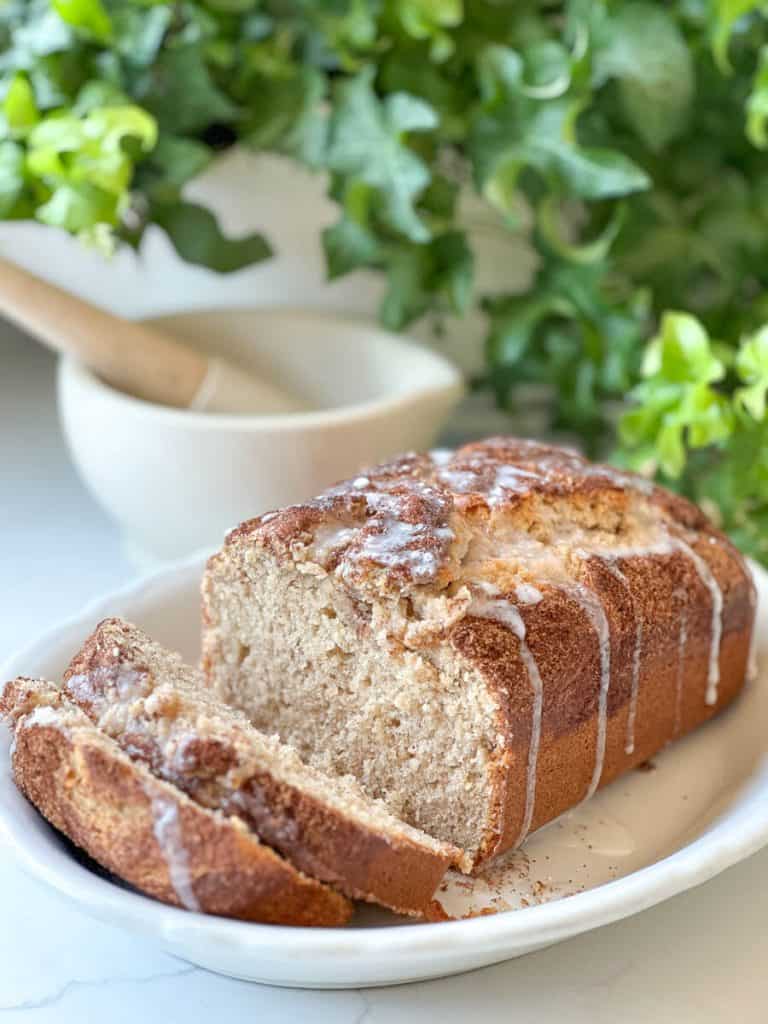



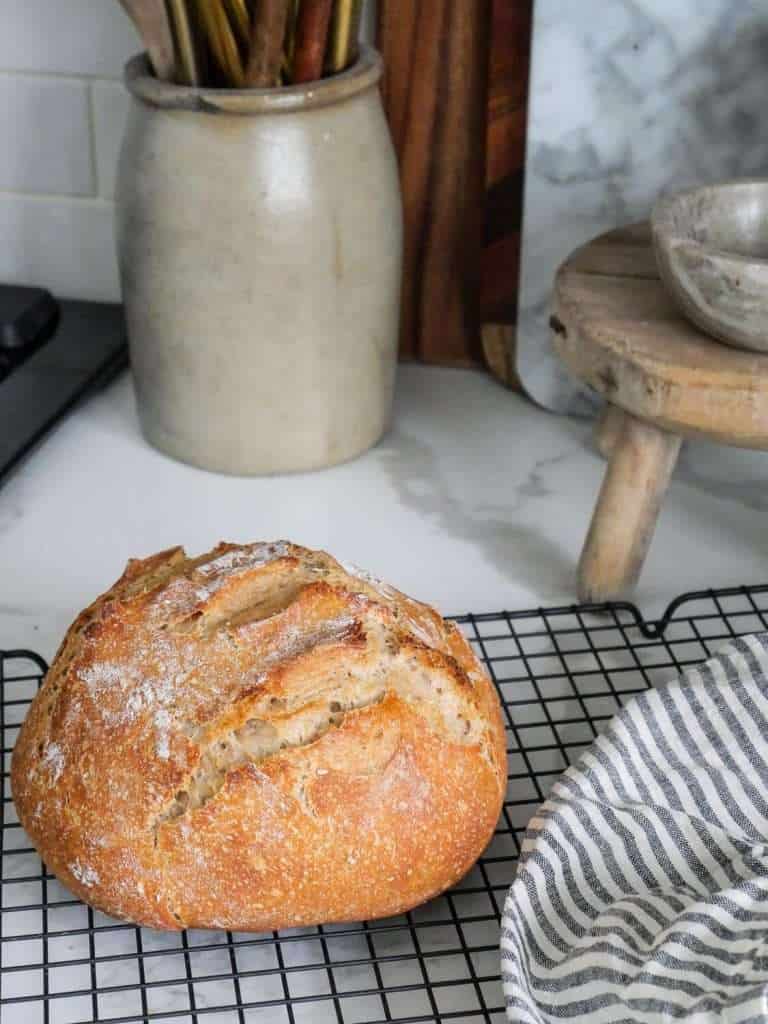
I appreciate the effort you put into spreading joy through your writing.